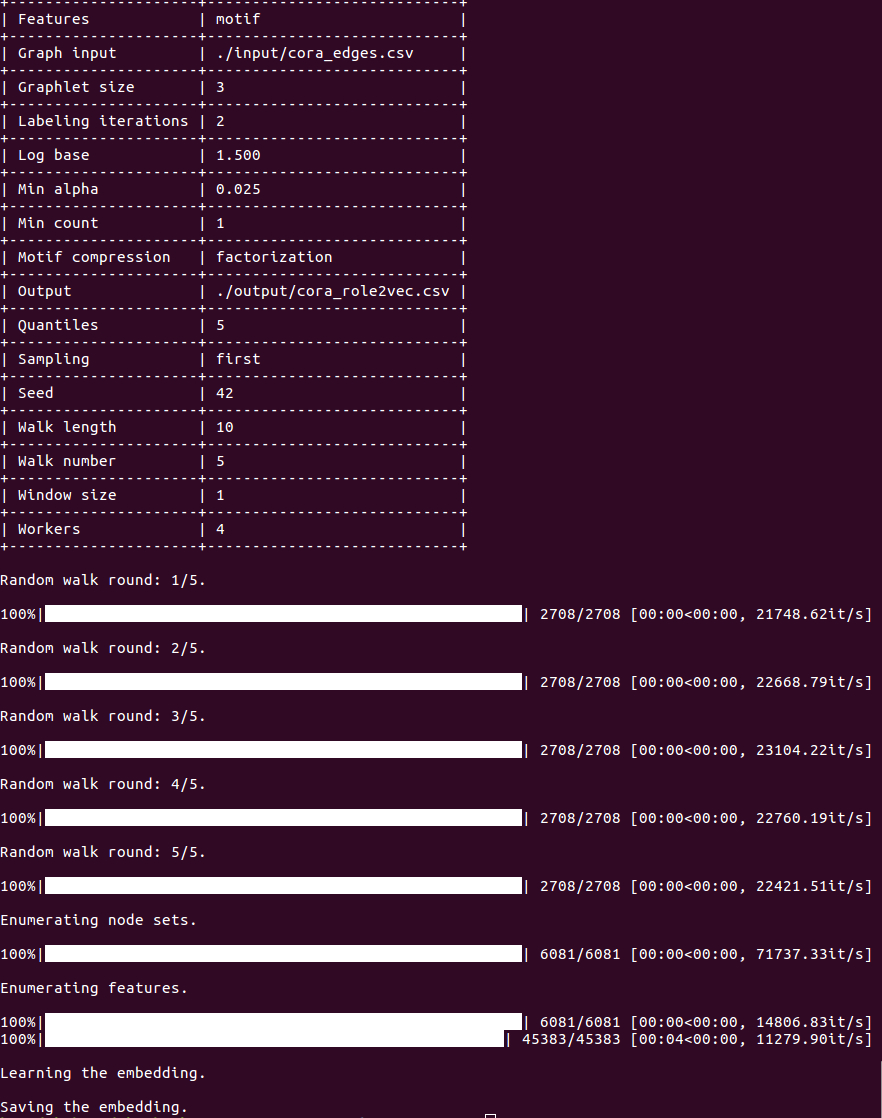benedekrozemberczki / Role2vec
Programming Languages
Labels
Projects that are alternatives of or similar to Role2vec
Role2Vec
A scalable parallel gensim implementation of Learning Role-based Graph Embeddings (IJCAI 2018).
Abstract
Random walks are at the heart of many existing network embedding methods. However, such algorithms have many limitations that arise from the use of random walks, e.g., the features resulting from these methods are unable to transfer to new nodes and graphs as they are tied to vertex identity. In this work, we introduce the Role2Vec framework which uses the flexible notion of attributed random walks, and serves as a basis for generalizing existing methods such as DeepWalk, node2vec, and many others that leverage random walks. Our proposed framework enables these methods to be more widely applicable for both transductive and inductive learning as well as for use on graphs with attributes (if available). This is achieved by learning functions that generalize to new nodes and graphs. We show that our proposed framework is effective with an average AUC improvement of 16.55% while requiring on average 853x less space than existing methods on a variety of graphs.
The second-order random walk sampling methods were taken from the reference implementation of Node2vec.
The model is now also available in the package Karate Club.
This repository provides an implementation of Role2Vec as described in the paper:
Learning Role-based Graph Embeddings. Nesreen K. Ahmed, Ryan Rossi, John Boaz Lee, Theodore L. Willke, Rong Zhou, Xiangnan Kong, Hoda Eldardiry. StarAI workshop - IJCAI, 2018. [Paper]
Requirements
The codebase is implemented in Python 3.5.2. package versions used for development are just below.
networkx 2.4
tqdm 4.28.1
numpy 1.15.4
pandas 0.23.4
texttable 1.5.0
scipy 1.1.0
argparse 1.1.0
gensim 3.6.0
scikit-learn 0.20.0
Datasets
The code takes the **edge list** of the graph in a csv file. Every row indicates an edge between two nodes separated by a comma. The first row is a header. Nodes should be indexed starting with 0. A sample graph for `Cora` is included in the `input/` directory.
Training the model is handled by the `src/main.py` script which provides the following command line arguments.
Input and output options
--graph-input STR Input graph path. Default is `input/cora_edges.csv`.
--output STR Embeddings path. Default is `output/cora_role2vec.csv`.
Random walk options
--window-size INT Skip-gram window size. Default is 5.
--walk-number INT Number of walks per node. Default is 10.
--walk-length INT Number of nodes in walk. Default is 80.
--sampling STR Sampling procedure. Default is `first`.
--P FLOAT Return parameter. Default is 1.0.
--Q FLOAT In-out parameter. Default is 1.0.
Factorization options
--dimensions INT Number of dimensions. Default is 128
--down-sampling FLOAT Down sampling frequency. Default is 0.001.
--alpha FLOAT Initial learning rate. Default is 0.025.
--min-alpha FLOAT Final learning rate. Default is 0.025.
--min-count INT Minimal feature count. Default is 1
--workers INT Number of cores. Default is 4.
--epochs INT Number of epochs. Default is 10.
Feature creation options
--features STR Feature extraction mechanism. Default is `wl`.
--labeling-iterations INT Number of WL labeling iterations. Default is 2.
--log-base FLOAT Log base for label creation. Default is 1.5.
--graphlet-size INT Maximal graphlet size. Default is 4.
--quantiles INT Number of quantiles for binning. Default is 5.
--motif-compression STR Motif compression procedure. Default is `string`.
--seed INT Sklearn random seed. Default is 42.
--factors INT Factors for motif compression. Default is 8.
--clusters INT Number of motif based labels. Default is 50.
--beta FLOAT Motif compression regularizer. Default is 0.01.
Examples
The following commands learn a Role2Vec embedding. The first example trains an embedding based on the default dataset with standard hyperparameter settings. The script saves the embedding at the default path.
``` python src/main.py ```Using the degree centrality as a structural feature.
python src/main.py --features degree
Using the Weisfeiler-Lehman labeling as a structural feature.
python src/main.py --features wl
Using motif based structural features with factorization compression.
python src/main.py --features motif --motif-compression factorization
Using motif based structural features with factorization compression and a structural label number of 40.
python src/main.py --features motif --motif-compression factorization --clusters 40
Using a custom factorization dimension for the embedding.
python src/main.py --dimensions 32
Using second-order attributed ranom walks for sampling.
python src/main.py --sampling second --P 1 --Q 4
License





